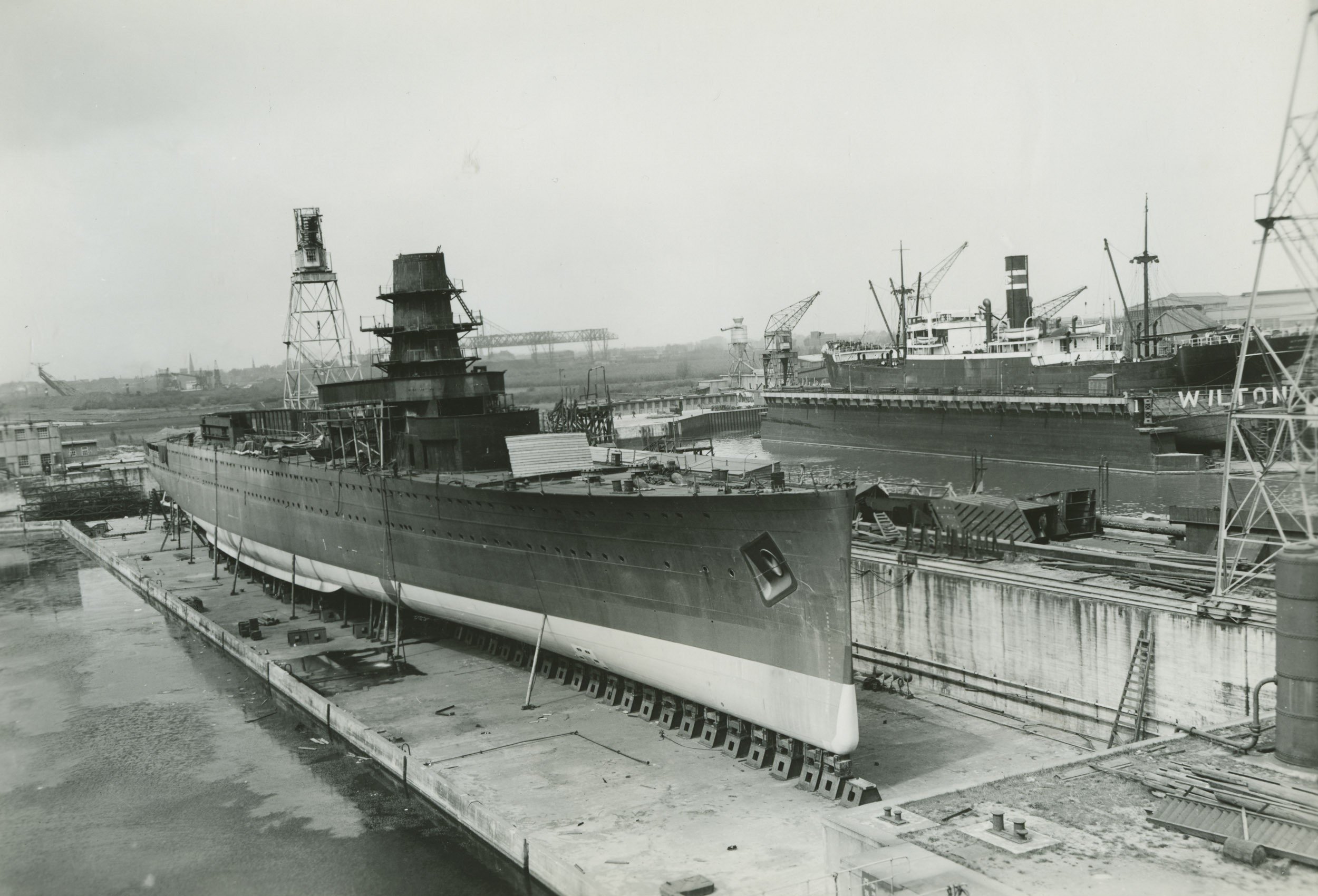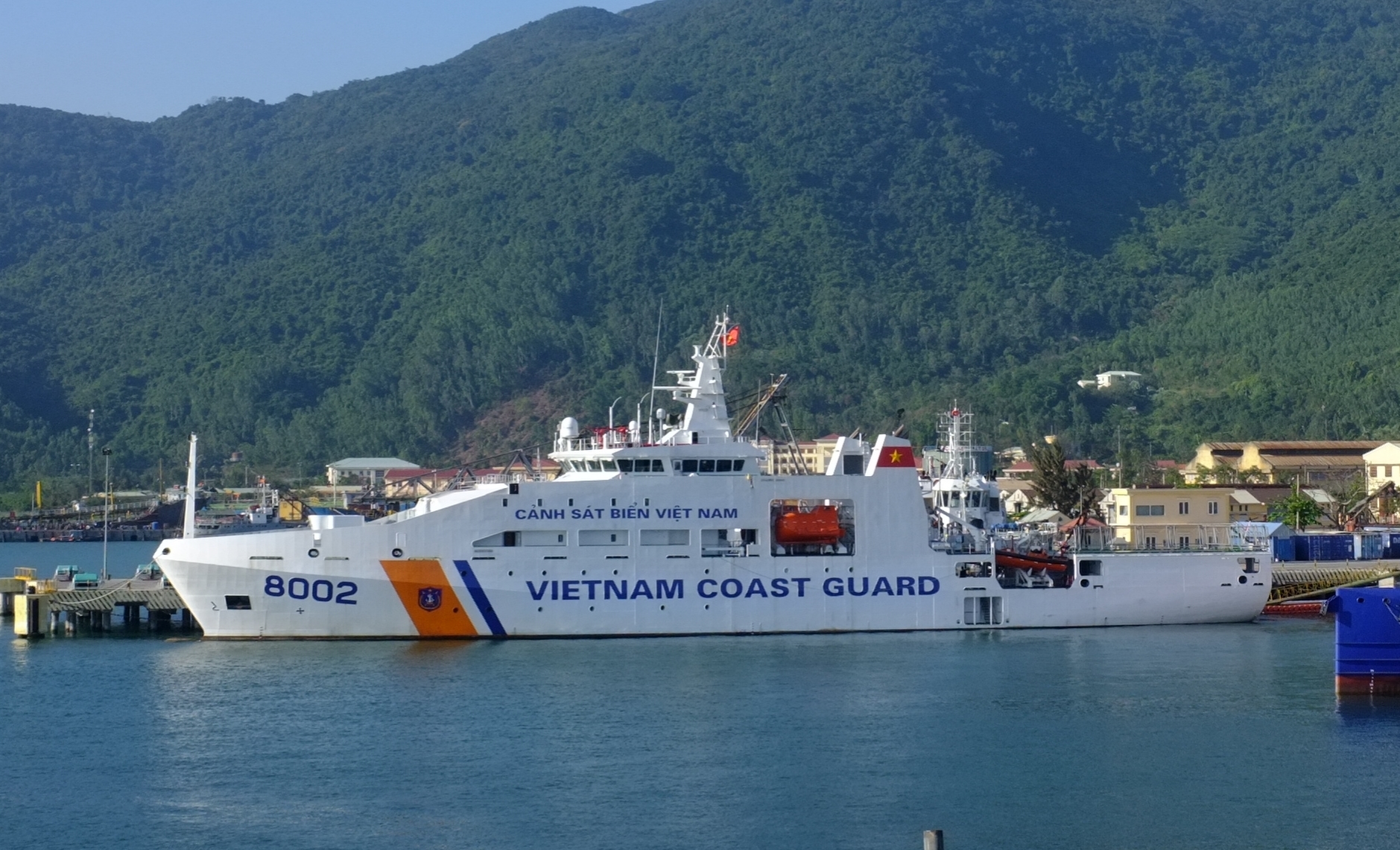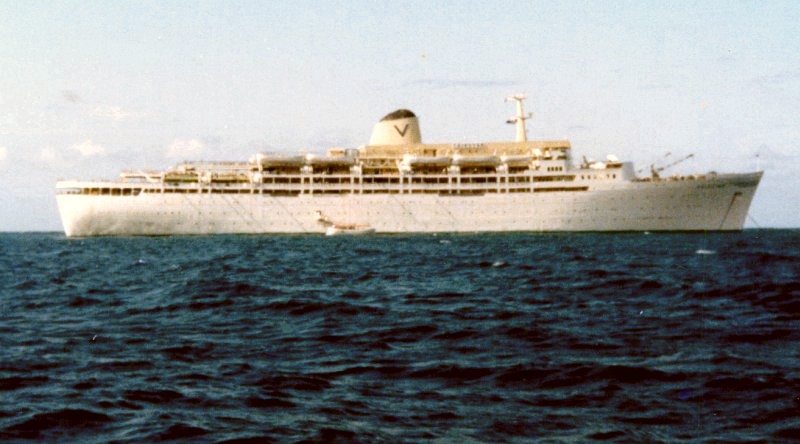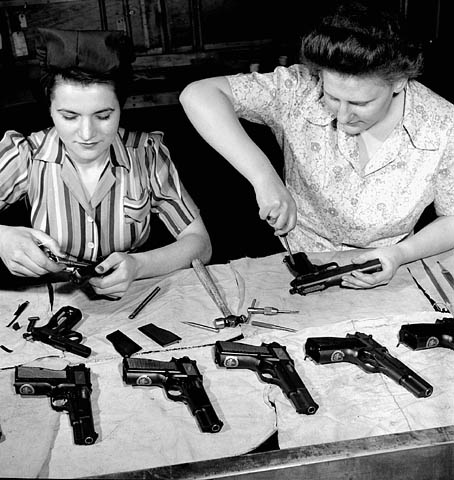|
Wilton-Fijenoord
Wilton-Fijenoord was a shipbuilding and repair company in Schiedam the Netherlands from 1929 to 1999. Presently, the shipyard of Wilton-Feijnoord is part of Damen Shiprepair Rotterdam. Merger of Wilton and Fijenoord (1929) Wilton-Fijenoord had two predecessors. Wilton's Dok- en Werf Maatschappij was the biggest predecessor of Wilton-Fijenoord, the other was the Shipyard Fijenoord. By the mid 1920s these shipyards had become rather similar. Wilton still had an advantage in ship repair, and Fijenoord was still ahead in ship construction, especially for the navy. The idea for a merger dated as far back as at least 1927. The rationale was that the still profitable Wilton company had a major overcapacity and was spread over two locations. The activities of Fijenoord could just as well be done in Schiedam. A concentration of the combined activities in Schiedam would lead to major cost savings. In 1929 talks led to an agreement for a financial merger between the companies. Shares in Wil ... [...More Info...] [...Related Items...] OR: [Wikipedia] [Google] [Baidu] |
Wilton's Dok- En Werf Maatschappij
Wilton's Dok- en Werf Maatschappij was a Dutch shipbuilding company active as an independent company from 1854 till 1929. At first it was simply known as 'Wilton'. In 1921 the final Dutch name became: 'Wilton's Dok- en Werf Maatschappij NV', the equivalent of 'Wilton Engineering and Slipway Company'. Wilton started as a traditional smithy and expanded in machinery. It specialized in ship repairs, but also became a shipyard. At first only for fresh water ships. In spite of multiple name changes the company was commonly referred to as 'Wilton'. In 1929 a merger with Fijenoord led to a new company known as Wilton-Fijenoord. Founded as a smithy in Rotterdam center Bartel Wilton Sr. (1828-1898) had left Rotterdam to work on a shipyard in London. While there, his old father was living in humble circumstances near the country house of the merchant and regent Abram van Rijckevorsel (1790-1864). Van Rijckevorsel and his friend the shipping magnate Willem Ruys (1837-1901) got an idea to h ... [...More Info...] [...Related Items...] OR: [Wikipedia] [Google] [Baidu] |
Fijenoord
Fijenoord () was a shipbuilding company and machine factory in Rotterdam the Netherlands from 1823 to 1929. In 1929 it merged with Wilton to become Wilton-Fijenoord. Early years First ships and activities of the NSM In 1822 a number of businessmen and women and the engineer Gerhard Mauritz Roentgen. founded Van Vollenhoven, Dutilh en Co. In June 1823 ''De Nederlander'', the first Dutch steamboat (with English engines) started its service, which would become a line between Rotterdam and Antwerp. In 1824 the Nederlandsche Stoomboot Maatschappij (NSM, but also NSBM) was founded and succeeded to Van Vollenhoven, Dutilh en Co. Roentgen became one of its two executives. NSM was primarily a shipping line. Its first business activities consisted of founding a number of lines from Rotterdam to Antwerp, Veere, Nijmegen and Arnhem. The required ships and in particular their engines, were designed by Roentgen. The first hulls were built by other companies, but the steam engines were a ... [...More Info...] [...Related Items...] OR: [Wikipedia] [Google] [Baidu] |
BAP Almirante Grau (CLM-81)
BAP ''Almirante Grau'' (CLM-81) is a cruiser that served in the Dutch and Peruvian navies. Completed for the Dutch in 1953 as HNLMS ''De Ruyter'' (C801), she was acquired by Peru in 1973 and served as fleet flagship. ''Almirante Grau'' underwent a major modernization program between 1985 and 1988 during which she was fitted with new weapons and electronics. She was the last gun cruiser in service in any navy before being decommissioned on 26 September 2017. In 2019, it was to be said that she would be preserved as a museum ship. However, it was later announced on 14 February 2022 that the ship would put up for sale with an asking price of 4,180,000 soles (1,112,520 USD). Construction ''De Ruyter'' was laid down by the Royal Netherlands Navy on 5 September 1939 as the cruiser HNLMS ''De Zeven Provinciën'' at the Wilton-Fijenoord shipyard at Schiedam. She and her sister-ship, later ', were intended to replace the two s in the Dutch East Indies. At the German invasion of t ... [...More Info...] [...Related Items...] OR: [Wikipedia] [Google] [Baidu] |
Damen Group
The Damen Group is a Dutch defence, shipbuilding, and engineering conglomerate company based in Gorinchem, Netherlands. Though it is a major international group doing business in 120 countries, it remains a private family-owned company. Damen Shipyards Group is a globally operating company with more than 50 shipyards, repair yards, and related companies − as well as numerous partner yards that can build Damen vessels locally. Since 1969 it has designed and built more than 5,000 vessels and delivers over 150 vessels annually. With over 30 shipyards and related companies worldwide, Damen is involved in ship construction as well as maintenance and repair activities. It has a wide product range, including tugs, workboats, patrol craft, cargo vessels, dredgers, superyachts and fast ferries. Product design and engineering are carried out in-house and a broad range of designs are available. History Overview Damen was established in 1927 in the town of Hardinxveld-Giessendam ... [...More Info...] [...Related Items...] OR: [Wikipedia] [Google] [Baidu] |
Fairstar
TSS (Turbine Steam Ship) ''Fairstar'' (''Fairstar, the Fun Ship'') was a popular Australian-based cruise ship operating out of Sydney for 22 years. Originally completed in 1957 as the British troopship ''Oxfordshire'', it was converted to become the ''Fairstar'' in 1964 for immigrant voyages and from December 1974 was permanently engaged in cruising. Background In the early 1950s, the British War Office still regularly required the transportation of troops to and from garrisons in many parts of the Empire. The Ministry of Transport had contracts with several shipping lines to transport the officers, troops and their families. One particular shipping company, The Bibby Line, had a long history of transporting troops; in fact from as early as 1854 during the Crimean War. In 1953, Bibby Line was made an attractive offer by the British Government to build a new vessel for troop transport. A simultaneous arrangement was made with the British-India Steam Navigation Company for an a ... [...More Info...] [...Related Items...] OR: [Wikipedia] [Google] [Baidu] |
Schiedam
Schiedam () is a city and municipality in the west of the Netherlands. It is located in the Rotterdam–The Hague metropolitan area, west of Rotterdam, east of Vlaardingen, and south of Delft. In the south the city is connected with the village of Pernis by the Beneluxtunnel. The city is known for its historical center with canals, and for having the tallest windmills in the world. Schiedam is also well known for the distilleries and malthouses and production of jenever ( gin) − such as the internationally renowned Ketel One − so much so that in French and English the word ''schiedam'' (usually without a capital ''s-'') refers to the town's Holland gin. This was the town's main industry during the early Industrial Revolution in the 18th and 19th century, a period to which it owed its former nickname "Zwart Nazareth" or "Black Nazareth". Furthermore, the city is known for Saint Lidwina, one of the most famous Dutch saints (her relics are located in the Liduina Basilica ... [...More Info...] [...Related Items...] OR: [Wikipedia] [Google] [Baidu] |
NV Ingenieurskantoor Voor Scheepsbouw
NV Ingenieurskantoor voor Scheepsbouw (''Dutch: engineer-office for shipbuilding''), usually contracted to IvS, was a Dutch dummy company set up in The Hague and funded by the ''Reichsmarine'' after World War I in order to maintain and develop German submarine know-how and to circumvent the limitations set by the Treaty of Versailles. The company designed several submarine types for paying countries, including the Soviet S-class submarine, as well as the prototypes for the German Type II submarines and Type VII submarines. The company was a joint venture by the German shipyards AG Vulcan Stettin (located in Stettin and Hamburg), the Krupp-owned Germaniawerft in Kiel, and AG Weser in Bremen. Design work was carried out at the facilities of these companies in Germany. Background information At the time of IvS, the Germans were bound by the Treaty of Versailles, signed in 1919. This treaty, among other terms, demanded that all German U-boats be destroyed or given to other na ... [...More Info...] [...Related Items...] OR: [Wikipedia] [Google] [Baidu] |
Kriegsmarine
The (, ) was the navy of Germany from 1935 to 1945. It superseded the Imperial German Navy of the German Empire (1871–1918) and the inter-war (1919–1935) of the Weimar Republic. The was one of three official branches, along with the and the , of the , the German armed forces from 1935 to 1945. In violation of the Treaty of Versailles, the grew rapidly during German naval rearmament in the 1930s. The 1919 treaty had limited the size of the German navy and prohibited the building of submarines. ships were deployed to the waters around Spain during the Spanish Civil War (1936–1939) under the guise of enforcing non-intervention, but in reality supported the Nationalists against the Spanish Republicans. In January 1939, Plan Z, a massive shipbuilding program, was ordered, calling for surface naval parity with the British Royal Navy by 1944. When World War II broke out in September 1939, Plan Z was shelved in favour of a crash building program for submarines ( U-b ... [...More Info...] [...Related Items...] OR: [Wikipedia] [Google] [Baidu] |
Westerdam In Aanbouw Op Werf Wilton-Fijenoord, Bestanddeelnr 901-4774
MS ''Westerdam'' is a owned by Holland America Line. She is the third ship of the class to be operated by the line, as well as being the third ship to bear the name ''Westerdam''. Her sister ships are , , and . The beginning of the four ships' names represent the four directions of the compass in Dutch. Construction and career ''Westerdam'' was christened on 25 April 2004 in Venice, Italy by Dutch actress Renée Soutendijk. As with all Vista-class ships, ''Westerdam'' is equipped with a CODAG power plant and an Azipod propulsion system. The theme of her art collection is Dutch heritage in the New World. Paintings of historic Dutch ships, such as Henry Hudson's ''Halve Maen'' (Half Moon), and various sculptures and statues are displayed throughout the ship. Contemporary pieces include an original Andy Warhol portrait and sculptures by Sedona artist Susanna Holt. In an April 2007 refit 34 cabins were added as well as modifications to several public areas of the ship. On 10 ... [...More Info...] [...Related Items...] OR: [Wikipedia] [Google] [Baidu] |
Feijenoord District
Feijenoord (), not to be confused with the Feijenoord neighbourhood (which is located in the Feijenoord district), is a district in Rotterdam and is located south of the Nieuwe Maas. As of 1 January 2004 there were 72,320 inhabitants. The area is 6.44 km² (1.45 km² of this is water). It is not the current home of the city's main football club, Feyenoord, which is now in the neighbouring township of IJsselmonde. The district gained significance in the 19th century as a centre of shipbuilding, principally at the Fijenoord yard. Neighbourhoods in Feijenoord * Afrikaanderwijk * Bloemhof * Feijenoord * Hillesluis * Katendrecht * Kop van Zuid * Noordereiland * Vreewijk Ethnicity The majority of the population of Feijenoord are immigrants, approximately 36% of the population are Dutch natives, 8% are western immigrants and 56% are non-western immigrants. The biggest non-western immigrant groups are Moroccan (10%), Netherlands Antillean (4%), Surinamese (11%) and ... [...More Info...] [...Related Items...] OR: [Wikipedia] [Google] [Baidu] |
Arms Industry
The arms industry, also known as the arms trade, is a global industry classification, industry which manufacturing, manufactures and sells weapons and military technology. It consists of a commerce, commercial Private industry, industry involved in the research and development, engineering, production, and servicing of military material, equipment, and facilities. Arms-producing companies, also referred to as arms dealers, or as the military industry, produce arms for the armed forces of State (polity), states and for civilians. Departments of government also operate in the arms industry, buying and selling weapons, munitions and other military items. An arsenal is a place where arms and ammunition - whether privately or publicly owned - are made, maintained and repaired, stored, or issued, in any combination. Products of the arms industry include guns, artillery, ammunition, missiles, military aircraft, military vehicles, Naval ship, ships, electronics, electronic systems, milita ... [...More Info...] [...Related Items...] OR: [Wikipedia] [Google] [Baidu] |
William Doxford & Sons
William Doxford & Sons Ltd, often referred to simply as Doxford, was a British shipbuilding and marine engineering company. History William Doxford founded the company in 1840. From 1870 it was based in Pallion, Sunderland, on the River Wear in Northeast England. The Company was managed by William Doxford's four sons following his death in 1882. It was acquired by Northumberland Shipbuilding Company in 1918. It was renamed ''Doxford & Sunderland Shipbuilding & Engineering Co Ltd'' in 1961 and ''Doxford & Sunderland Ltd'' in 1966. Court Line took it over in 1972 and renamed it ''Sunderland Shipbuilders Ltd''. In the 1970s a new all-weather Pallion yard was built which could build two ships of up to 30,000 tons deadweight side-by-side. The steel came in at one end, and the completed ship left from the other with engines installed and sometimes with the machinery running. Court Line collapsed in 1974 and the company was nationalised. It was privatised in 1986 when it was ... [...More Info...] [...Related Items...] OR: [Wikipedia] [Google] [Baidu] |








.jpg)